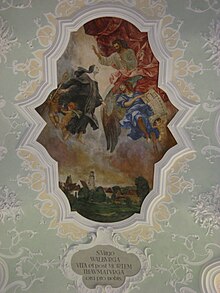Monheim Monastery
The Monheim Monastery was a Benedictine abbey in Monheim (Swabia) in Bavaria in the diocese of Eichstätt .
history
The Benedictine Abbey Monheim, the "Monasterium Mowanheim / Mouwenheim / Mouvanheim", was founded around 870 as an aristocratic monastery with its own church by Liubila as the first abbess together with her biological sister (and successor as abbess) Gerlinda in a Bavarian-Alemannic area that has been populated since 700. The first mention of the monastery comes from a document from 893, which was probably signed on April 30th in Eichstätt: In order to secure their monastery, Liubila and Gerlinda transferred their own property in Monheim with the consent of the other convent members to Bishop Erchanbald von Eichstätt. The transfer of relics of St. Walburga on May 1, 893 from Eichstätt to Monheim let the Monheim monastery quickly grow into a pilgrimage center of the late Carolingian period . From 894 to about 899, the Eichstätter cathedral cleric Wolfhard von Herrieden (* 882 ?; † 912) wrote the hagiographic "Miracula S. Waldburgis Monheimensia" (= miracle of St. Walburga zu Monheim) in four books , in which he legendarily gives a first biography of the Diocesan saints and over 50 miracles related to their Monheim relics.
Over the centuries the monastery continued to develop calmly; it had possessions in more than 40 places, mainly in the vicinity. Remote ownership can be proven in the Upper Palatinate and in Mergentheim . At the end of the 14th century, the monastery and with it the pilgrimage system experienced a certain decline. In 1446 the abbess Margareta Wurmrauscher waived her benefice for eight years in order to reduce the monastery debt. In the 16th century, as in many other monasteries of this time, the monastic discipline had decreased significantly. After Monheim fell into the hands of the newly founded Duchy of Palatinate-Neuburg in 1505 , Count Palatine Ottheinrich and his brother Philip obtained permission from Pope Clement VII to abolish the monastery in 1530 . The last abbess named Eschwek died in 1533.
In 1542 the Reformation was introduced in the Palatinate; The Walburga reliquary shrine in Monheim has been missing since 1555, and the monastery was demolished in 1574. Only the western wing of the cloister ( Romanesque ; 13th century) and a monastery building, which was converted into a parish center and youth home in 1977, the "Holzapfelhaus" (around 12th century) on the south side of the former monastery and today's parish church of St. Walburga, remained.
After the re-catholicization of the Palatinate under Elector Wilhelm in 1614, most of the former monastery property was incorporated into the newly founded monastery of the Brothers of Mercy in Neuburg an der Donau in 1653 .
The former monastery and today's parish church of St. Walburga
The monastery church was a Salvatorkirche , d. H. Consecrated Jesus as the Savior . The consecration was carried out by the Eichstatt Bishop Gundekar II between 1057 and 1075. The monastic successor sacred building, today's parish church of St. Walburga, was built in 1509 as a late Gothic three-aisled hall church and replaced the older parish church, a St. Peter's church "on a mountain slope". The monastery church was restored in 1596 and was baroque between 1700 and 1740 . The five altars were acquired from there in 1803 when the Kaisheim monastery was dissolved . The stucco pulpit dates from 1721 by the Eichstatt plasterer Jakob Eck . Since October 12, 1700, the church has again had Walburga relics, a “Particul von dem armb Bain”, which triggered a strong stream of pilgrims, especially from the rural area. The reliquary is now in the Walburga Chapel to the left of the choir, where there is also a silver statue of St. Walburga, a work by an Augsburg artist around 1700, which could be saved during the secularization in Bavaria through a transfer payment. In 1908-11 the church and the remains of the cloister were restored with new ceiling paintings. The church tower dates from 1340. In 2009, as part of the church tower renovation, the ringing was extended to 7 bells and at the same time the iron bell cage was replaced with a new oak wood bell cage.
literature
- Beda Grundl: A death and salary book of the Monheim monastery from 1381. In: Collective sheet of the historical association Eichstätt 2 (1887), p. 76f.
- Franz Sales Romstöck: The founders and monasteries of the Diocese of Eichstätt up to 1806 . In: Collection sheet of the historical association Eichstätt 30 (1915), Eichstätt 1916, p. 67f. (with bibliography)
- Monheim . In: Karl Bosl (Hrsg.): Handbook of the historical sites of Germany . Volume 7: Bavaria (= Kröner's pocket edition . Volume 277). 3. Edition. Kröner, Stuttgart 1981, ISBN 3-520-27703-4 , pp. 459f.
- Andreas Bauch: A Bavarian book of miracles from the Carolingian era. The Monheim Walpurgis miracles of the priest Wolfhard . (Sources on the history of the diocese of Eichstätt 3: Eichstädter Studies New Volume 12). Regensburg: Friedrich Pustet 1979, especially pp. 112–123
Web links
- About Monheim and its monastery (PDF; 140 kB)
Coordinates: 48 ° 50 ′ 28 " N , 10 ° 51 ′ 28" E

